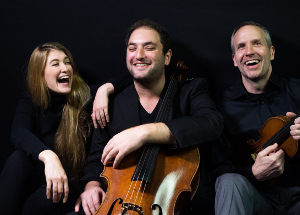Continuing a theme recently expounded by our colleague Marvin J. Ward, there was anything but standard fare at a recital coordinated by Ciompi Quartet violinist Eric Pritchard, presented on January 13 in Duke’s Nelson Music Room. The place was nearly full for the late-afternoon event, which competed directly with the McIver Ensemble’s chamber music program in Raleigh and an offering by the Concert Singers of Cary and Chamber Orchestra of the Triangle just down the road in Durham’s Carolina Theatre. The fact that the room was virtually packed meant that the sound in the refurbished jewel of the area’s small concert venues was better than it can be when the place is only partly occupied.
Pritchard has consistently demonstrated that he’s no slouch in the fiddling department. He’s also sufficiently secure in his abilities as a player and teacher that he feels completely comfortable dealing with other area professionals and advanced students, too. There were some of all of these folks on hand on this occasion.
The program began with music by Leclair and Bartók, rendered by Pritchard and his nominal counterpart at UNC-Chapel Hill, violinist Richard Luby, late of original-instruments fame but more recently regaining in a big way his “chops” on the modern fiddle. It is somewhat curious, therefore, that the opening work was a carryover from a time when gut strings were all the rage (because of course the art of spinning steel was not yet particularly advanced back then). Anyway, Leclair’s Sonata No. 3, in C, is a fine example of the somewhat showy pieces for which the composer is remembered, and the two artists delivered it with considerable flair and reasonable accuracy. It was followed by five of Bartók’s sometimes-thorny duos (nos. 21, 32, 28, 43 and 42, respectively), taken from a set of 44 pieces. Most of them are as brief as many of the composer’s Mikrokosmos selections, for piano. These were given with great polish by Pritchard and Luby and were warmly received by the enthusiastic crowd.
Next came an arrangement of Bach’s famous Chaconne, done by Pritchard and Oliver Sum-Ping, one of his exceptional students. It was apparently the world premiere of this adaptation for two violins, an adaptation that in turn apparently evolved during studio time shared by the two instrumentalists. It was of course bigger than the original but it seemed reasonably “natural” and it clearly eased considerably the fearsome difficulty of the original – although it was still no piece of cake. This transcription and the players’ reading of it were likewise heartily applauded.
Duke-based composer Scott Lindroth’s Duo (1990) was then played by Pritchard and Frances Hsieh, another of his advanced students. We’ve had the pleasure of hearing the piece previously and it is available on a CRI CD of Lindroth’s music, played by Veronica Macchia-Kadlubkiewicz and Curtis Macomber. As with other compositions by Lindroth, some advance preparation was probably helpful, as several hearings would surely have been for those experiencing it for the first time. It is a piece that is not immediately engaging but I found far more in it this go-’round than during earlier encounters. Like the Bartok, it served a useful function in the program by spicing up the palette, and it, too, was very handsomely played.
The program formally ended with a lovely four-movement Suite by Moszkowski, given with breathtaking commitment by Pritchard and his Ciompi Quartet colleague Hsiao-mei Ku. Like Pritchard, Ku is among the best of the best – one of the miracles of the Ciompi Quartet is its even distribution of talent and artistic insight among its members – so this was, perhaps predictably, a marvelous performance, ably abetted by pianist Jane Hawkins. It is salon music, more or less, but its melodies tug at the heartstrings.
The encore, another arrangement, tugged at the heartstrings, too, but perhaps not in a way the participants anticipated. Everyone took part – yes, Pritchard, Luby, Sum-Ping, Hsieh, Ku and Hawkins – in this version of Sarasate’s “Navarra,” intended for just two fiddles. It was fun, I suppose, but in this case, two would have been preferable to five – or else an orchestra should have been engaged, too, to provide a bit of cover for the not-always-flawlessly-matched string sound.











